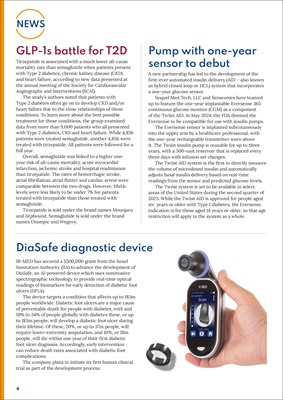
4
NEWS
GLP-1s battle for T2D
Tirzepatide is associated with a much lower all-cause
mortality rate than semaglutide when patients present
with Type 2 diabetes, chronic kidney disease (CKD)
and heart failure, according to new data presented at
the annual meeting of the Society for Cardiovascular
Angiography and Interventions (SCAI).
The study's authors noted that patients with
Type 2 diabetes often go on to develop CKD and/or
heart failure due to the close relationships of those
conditions. To learn more about the best possible
treatment for these conditions, the group examined
data from more than 9,000 patients who all presented
with Type 2 diabetes, CKS and heart failure. While 4,856
patients were treated semaglutide, another 4,856 were
treated with tirzepatide. All patients were followed for a
full year.
Overall, semaglutide was linked to a higher oneyear
risk of all-cause mortality, acute myocardial
infarction, ischemic stroke and hospital readmission
than tirzepatide. The rates of hemorrhagic stroke,
atrial fibrillation, atrial flutter and cardiac arrest were
comparable between the two drugs. However, HbA1c
levels were less likely to be under 7% for patients
treated with tirzepatide than those treated with
semaglutide.
Tirzepatide is sold under the brand names Mounjaro
and Zepbound. Semaglutide is sold under the brand
names Ozempic and Wegovy.
DiaSafe diagnostic device
Pump with one-year
sensor to debut
A new partnership has led to the development of the
first-ever automated insulin delivery (AID - also known
as hybrid closed loop or HCL) system that incorporates
a one-year glucose sensor.
Sequel Med Tech, LLC and Senseonics have teamed
up to feature the one-year implantable Eversense 365
continuous glucose monitor (CGM) as a component
of the Twiist AID. In May 2024, the FDA deemed the
Eversense to be compatible for use with insulin pumps.
The Eversense sensor is implanted subcutaneously
into the upper arm by a healthcare professional, with
the one-year rechargeable transmitter worn above
it. The Twiist insulin pump is reusable for up to three
years, with a 300-unit reservoir that is replaced every
three days with infusion set changes.
The Twiist AID system is the first to directly measure
the volume of microdosed insulin and automatically
adjusts basal insulin delivery based on real-time
readings from the sensor and predicted glucose levels.
The Twiist system is set to be available in select
areas of the United States during the second quarter of
2025. While the Twiist AID is approved for people aged
six years or older with Type 1 diabetes, the Eversense
indication is for those aged 18 years or older, so that age
restriction will apply to the system as a whole.
IR-MED has secured a $500,000 grant from the Israel
Innovation Authority (IIA) to advance the development of
DiaSafe, an AI-powered device which uses noninvasive
spectrographic technology to provide real-time optical
readings of biomarkers for early detection of diabetic foot
ulcers (DFUs).
The device targets a condition that affects up to 183m
people worldwide. Diabetic foot ulcers are a major cause
of preventable death for people with diabetes, with and
19% to 34% of people globally with diabetes these, or up
to 183m people, will develop a diabetic foot ulcer during
their lifetime. Of these, 20%, or up to 37m people, will
require lower-extremity amputation, and 10%, or 18m
people, will die within one year of their first diabetic
foot ulcer diagnosis. Accordingly, early intervention
can reduce death rates associated with diabetic foot
complications.
The company plans to initiate its first human clinical
trial as part of the development process.